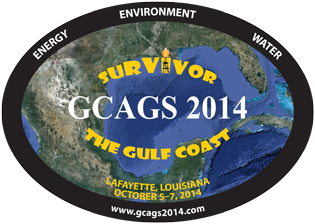Trip #1: Wax Lake Delta
Instructor: Dr. Harry H. Roberts, Director, Coastal Studies Institute, Louisiana State University
• Saturday, Oct. 4, 2014
• 8:30 am–5:00 pm
• Departure from parking lot of Hilton Garden Inn (2350 W. Congress St.)
• $255 per person (cost includes bus transportation to and from Wax Lake area, boat transportation in the field with boat captains and field technicians, lunch and refreshments, and guidebook)
• Max. 28 participants
| The Wax Lake and Atchafalaya deltas represent the embryonic stages of a new Mississippi River delta complex, adding to the previous five delta complexes that have formed Louisiana’s coastal plain. Historical accounts document that the Atchafalaya River has been a distributary of the Mississippi since the 1500s. It was evident by the mid-1900s that the Atchafalaya River was steadily capturing more and more discharge from the Mississippi. In 1963, a control structure was completed by the U.S. Army Corps of Engineers at Old River, the confluence of the two rivers. This structure limits flow down the Atchafalaya River to about 30% of the Mississippi discharge. Following the enormous flood of 1973 the Old River Control Structure was almost lost. This same flood caused both |
 |
the Atchafalaya and Wax Lake deltas to evolve from being subaqueous features to subaerial forms.
|
 |
This field trip will offer the opportunity to learn about the Wax Lake Delta (unmodified by human activities), its general evolution, sedimentary architecture, and how it fits into the larger framework of the Mississippi River Delta. An orientation lecture at the Patterson, LA, boat launch will discuss the overall setting for Atchafalaya–Wax Lake deltas, including the precursor filing of Atchafalaya Basin. We will then travel by boat to different deltaic environments, and concentrate on the processes of formation and sedimentary architecture of the Wax Lake Delta. We will collect a vibracore from a representative lobe of the delta and use it to discuss sedimentary facies, facies successions, and potential reservoir characteristics. In recent years, the Wax Lake Delta has been used as a model for large-scaleriver diversions, |
| our best hope for offsetting Louisiana’s coastal land loss. The trip should be informative for geoscientists working in the oil and gas industry as well as geologists, biologists, engineers, and managers involved in solving coastal problems. |
Trip #2: Geomorphology and Hydrogeology of the Lafayette Area
Instructors: Dr. Timothy W. Duex and Dr. Gary L. Kinsland, Geosciences Faculty,
University of Louisiana at Lafayette
• Sunday, Oct. 5, 2014
• 8:00 am–5:00 pm
• Departure from parking lot of Hilton Garden Inn (2350 W. Congress St.)
• $65 per person (cost includes transportation, lunch and refreshments, and guidebook)
• Max. 18 participants
The Lafayette area is a moderate size metropolitan area that is experiencing relatively rapid growth. As the region grows, it faces numerous issues that include: (1) active floodplains; (2) bidirectional flood flow in Bayou Vermilion; (3) drainage influenced by the topography of (a) faults associated with a state-spanning fault system, (b) Pleistocene Mississippi River meanders, and (c) Pleistocene Red River distributary channels; (4) a perched water table within Quaternary loess; and (5) concerns about ground water supply and pollution in the Chicot Aquifer. Policy makers and geoscientists have become more aware of these interactions as municipalities and businesses have created more impervious surfaces with buildings, roadways, parking lots, “slab-constructed” houses, and “improved” concrete-lined coulees that also hasten drainage. This trip will look at a variety of features using aerial images, immersive 3D, and field stops, and relate them to urban and suburban development and concomitant effects.
Trip #3: The Use of Louisiana Salt Domes and Associated Geological Difficulties — Exploration, Production, and Storage
Instructor: William H. Schramm, Geologist Supervisor, Louisiana Department of Environmental Quality
(CANCELED)
• Sunday, Oct. 5, 2014
• 7:00 am–3:00 pm
• Departure from parking lot of Hilton Garden Inn (2350 W. Congress St.)
• $150 per person (cost includes transportation, lunch, and guidebook)
• Max. 14 participants
| Louisiana salt domes have been exploited for well over 150 years. Originally used for salt production, the later discovery and development of oil and gas resources encouraged the geologic study of the formation of intrusive salt bodies. Many exploration wells, seismic studies, gravity surveys, and mining activities have provided a detailed 3D conceptualization of these salt bodies. Brine production for chlorine and caustic supplies for the chemical industry as well as salt mining for consumer use and public safety in road deicing are a few of the most prominent uses. More recent exploitation of |
 |
salt domes has made use of existing and specially designed caverns for storage of a multitude of products, mainly related to the oil and gas and chemical industries. Since caverns were brought into use in the mid-1900s, they have experienced many instances of structural, mechanical, or geologic failure. People have lost their lives and livelihoods, industries have lost their products and business, and the nation has lost natural resources and societal use of the lands.
|
 |
This field trip will showcase three examples where loss of the caverns has resulted in extreme societal, resource, and financial loss. We will discuss the geological setting, uses of the location, events leading up to the loss of use, and resultant effect impacting the local people. The first stop is Lake Peigneur/Jefferson Island where petroleum exploration impacted the underground salt mining operation causing the loss of the entire mine, fortunately with no loss of life. The second stop is Weeks Island where the Federal government established a Strategic Petroleum Reserve. A sinkhole developed from natural processes that threatened the security and integrity of the SPR. The entire project had to |
| be abandoned at a large cost, but without the lost of lives or resources. The final stop is Bayou Corne where a cavern used for brine production failed due to poor understanding of geology and site location. Local residents have suffered substantial loss in use of property and industry has borne significant financial loss trying to contain the surface impact from the development of the sinkhole. Again fortunately, there has been no loss of life. |
|








